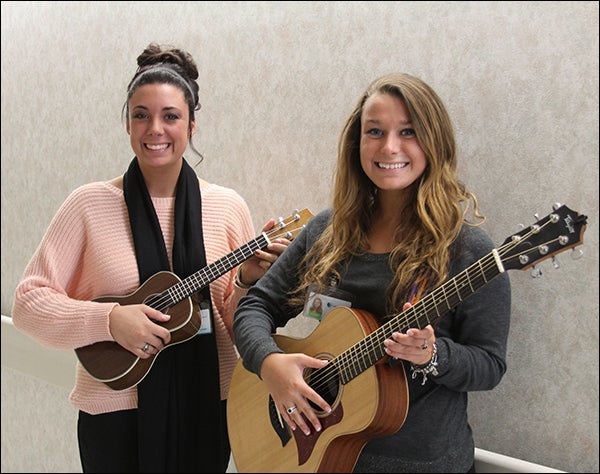ECU students use music therapy to help Vidant Medical Center patients

ECU music therapy students and Emily Selitto, left, and Amanda Bernstein help patients at Vidant Medical Center with music. Not pictured are Madaline Logan and Emily Margagliotti. (Contributed photo)
“The girls and their music made it much easier for him to go on to glory,” Brenda Daniels said. Her husband, Noah Daniels, passed away in January at Vidant Medical Center. She said she is eternally grateful for two East Carolina University music therapy students who spent time singing and playing music for her husband and family.
For more than 45 years, the East Carolina University Music Therapy program has been training students to help people through the power of music. This semester, four of those students have brought their talents to Vidant Medical Center, to work with patients on a weekly basis.
Noah Daniels was just one of the patients who benefited from their work. “He was having a hard time, but when those girls walked in, we were elated,” his wife said. “I could see by the look in his eyes and the expression on his face, how the music lifted his spirits.”
Each Thursday, ECU seniors and music therapy majors, Amanda Bernstein and Emily Selitto visit Vidant Medical Center and go room to room singing and playing instruments for some of the sickest patients. “It’s a very humbling and rewarding experience,” Bernstein said. “We aren’t just singing and playing music for ourselves, music therapy is so much more than that; we are using our talents to help people.”
Music therapy students are required to complete a 12 hour practicum each semester in order to graduate. “Our main goal is to help patients use music to complete tasks that they otherwise wouldn’t be able to,” said Selitto. “If we can be a distraction, lift their spirits, and help relax them, if only for a few minutes at a time, then we are successful.”
Dr. Michelle Hairston, professor and chair of music education and music therapy department at ECU explained that a music therapist is constantly assessing the responses of the patient and uses his or her training to formulate a goal– and then work on it immediately. “Music is the powerful tool that reaches the soul of every individual. It is nonthreatening and inviting,” said Dr. Hairston. “Music engages patients immediately, and the personal connection of the music therapist keeps that connection going. The power of the music, the human contact (by the music therapist) and the goal-directed interaction of the two, is what makes music therapy work.”
Patricia Rice, a physician assistant at Vidant Medical Center, has been a practicum mentor for the music therapy students for the last three years. “The influence that these students have with the patients is remarkable,” Rice said. “They have a way of using music to help the patients with pain management, relaxation, and increasing physical activity which helps the patients reengage into life.”
Their influence is especially true in regards to the Daniels family. Brenda Daniels was so impressed and inspired by Bernstein and Selitto, that she asked if they would perform at her husband’s funeral. The girls obliged and sang several hymns, including Amazing Grace. “I wish that I could repay them, for what they gave to me and my husband with their music,” Daniels said. “I’ve never experienced anything like that in my entire life.”
For more information about the ECU Music Therapy program, please contact Dr. Michelle Hairston at Hairstonm@ecu.edu.
Courtesy of Vidant Health Corporate Communications